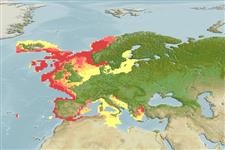Common names from other countries
Environment: milieu / climate zone / depth range / distribution range
Sinh thái học
; Mức độ sâu 20 - 800 m (Ref. 441), usually 200 - 600 m (Ref. 88009). Temperate, preferred 16°C (Ref. 107945); 72°N - 27°N, 25°W - 27°E
Eastern Atlantic and the Mediterranean: From Finnmark, Norway south to Libya west to the Canary Is. and east to Aegean Sea. Subtropical to polar.
Length at first maturity / Bộ gần gũi / Khối lượng (Trọng lượng) / Age
Maturity: Lm 3.2, range 2 - 5.5 cm Max length : 24.0 cm BL con đực/không giới tính; (Ref. 441); common length : 19.0 cm BL con đực/không giới tính; (Ref. 441)
Total body length: 8 to 24 cm, usually between 10 to 20 cm (Ref. 4). Found in the continental shelf and slope (Ref. 94799). Epibenthic (Ref. 87524). Sedentary (Ref. 94799). Inhabits muddy bottoms in which it digs its burrows. Nocturnal and feeds on detritus, crustaceans and worms (Ref. 4). An active predator or scavenger (Ref. 94757). Another isotope data (δ15N=6.26±0.14, n=3, Ref. 106518).
Ovigerous females are found practically throughout the year, the eggs laid around July are carried for about 9 months (Ref. 4). 1 brood per year (Ref. 81133); 1.6 cm postlarval size (Ref. 81161); 1 month of pelagic period (Ref. 81160).
Holthuis, L.B. 1991. (Ref. 4)
IUCN Red List Status (Ref. 130435)
CITES status (Ref. 108899)
Not Evaluated
Not Evaluated
Human uses
Các nghề cá: Tính thương mại
FAO - Các nghề cá: landings, species profile | FIRMS (Stock assessments) | FishSource | Biển chung quanh ta
Các công cụ
Các nguồn internet
Estimates based on models
Preferred temperature
(Ref.
115969): 3.3 - 13.7, mean 7.8 (based on 273 cells).
Thích nghi nhanh
Trung bình, thời gian nhân đôi của chủng quần tối thiểu là 1.4 - 4.4 năm (K=0.03-0.44; tm=2).
Prior r = 0.50, 95% CL = 0.33 - 0.75, Based on 36 full stock assessments.
Vulnerability
Low vulnerability (14 of 100).
